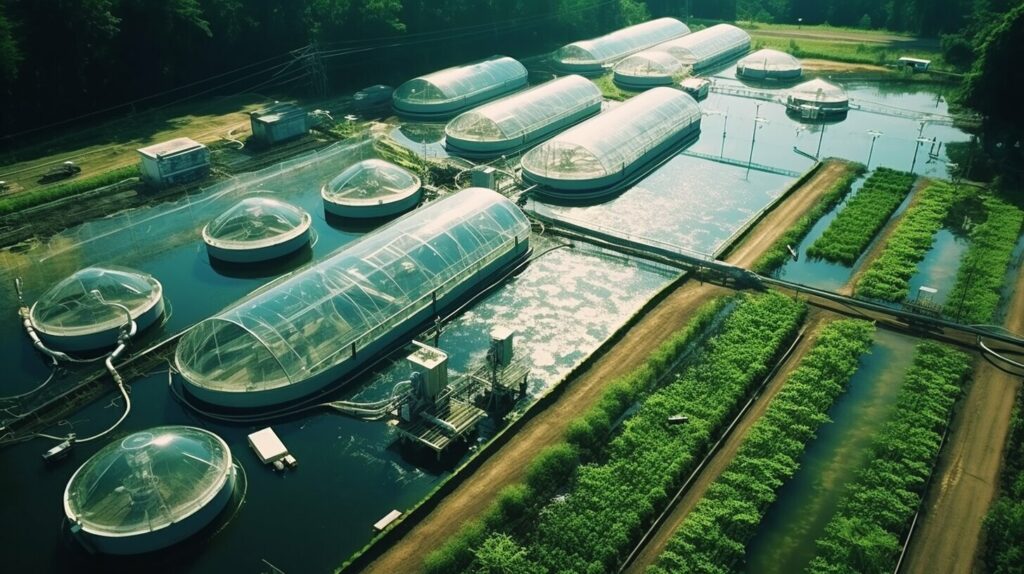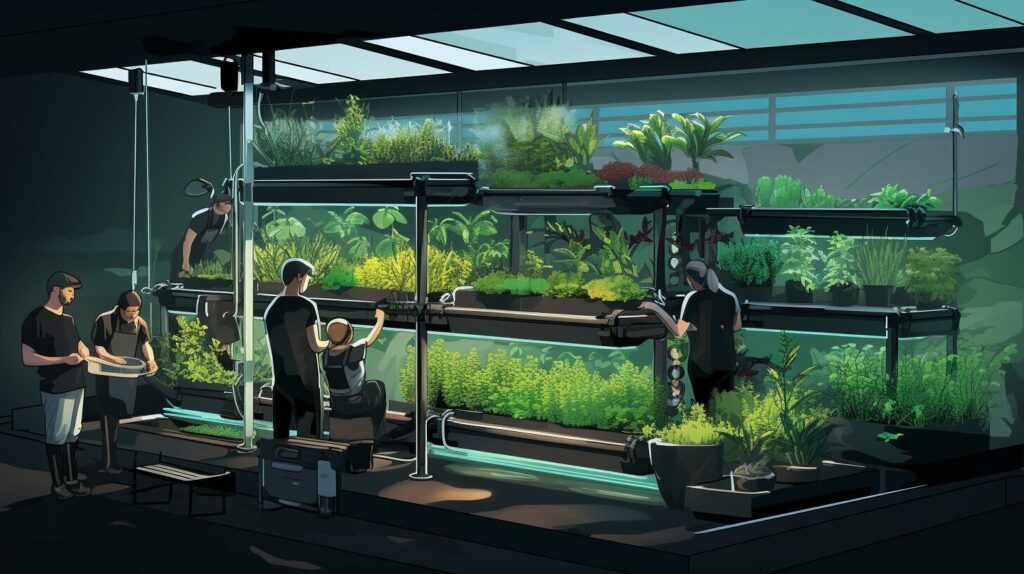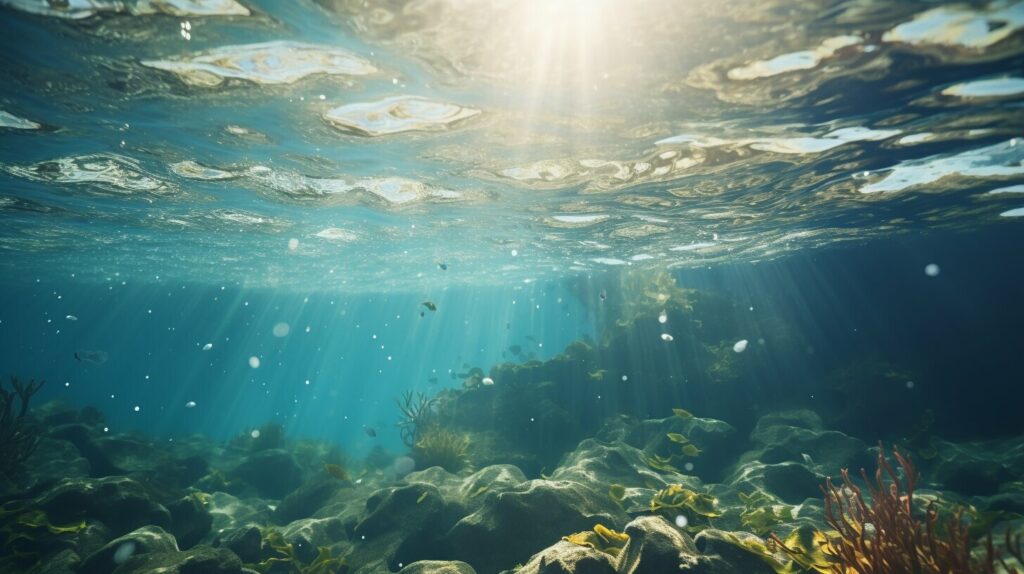This post may contain affiliate links and we may earn a small commission when you click on the links at no additional cost to you. As an Amazon Affiliate, we earn from qualifying purchases. You can read our full disclaimer here.
If you’re interested in aquaponics but have limited space, don’t worry. You can still design and build an aquaponics system that works for your small-scale setup. In fact, aquaponics is excellent for those with limited space, as it allows you to grow plants and raise fish in a self-sustaining environment.
However, you’ll be required to design your system correctly to optimize yield and ensure that fish and plants thrive. In this article, we’ll guide you through designing an aquaponics system for small spaces.
Whether you want to set up an indoor aquaponics system or a DIY aquaponics project, we’ll cover everything you need to know about essential components, water quality maintenance, maximizing plant growth, and troubleshooting common challenges. By the end of this guide, you’ll be ready to set up your own small aquaponics system and start growing your own fish and plants.
So, let’s dive in and explore the world of aquaponics systems for small spaces.
Key Takeaways
- Aquaponics is a sustainable system that combines plant cultivation and fish farming in a self-sustaining environment, perfect for small spaces.
- Components of an aquaponics system include a fish tank, grow bed, and water pump, which can be adapted to fit small-scale setups.
- Fish provide nutrients for plants through their waste, while plants purify the water for the fish, creating a symbiotic relationship.
- When designing an aquaponics system for small spaces, consider factors like available space, indoor or outdoor setup, and whether to use a DIY approach.
- Essential components for small-scale aquaponics include choosing an appropriately sized fish tank, a suitable grow bed, and a water pump with the right flow rate and head height.
- Maintaining water quality is crucial for system success, requiring regular testing, nitrifying bacteria buildup, balanced fish and plant ratios, and periodic water changes.
- To maximize plant growth in limited space, consider hydroponic techniques, suitable plant choices, and using clay pebbles as a growing medium.
- Troubleshooting challenges in small aquaponics systems involves managing pests, ensuring proper water flow, and providing the right amount of fish food.
- Setting up an aquaponics system in a small space involves careful component assembly, the use of clay pebbles as a grow medium, proper aeration, and gradual expansion as you gain experience.
- Ultimately, with dedication and the right approach, you can successfully design and maintain an aquaponics system in a small space, enjoying fresh produce and fish in an eco-friendly manner.
Understanding Aquaponics Systems
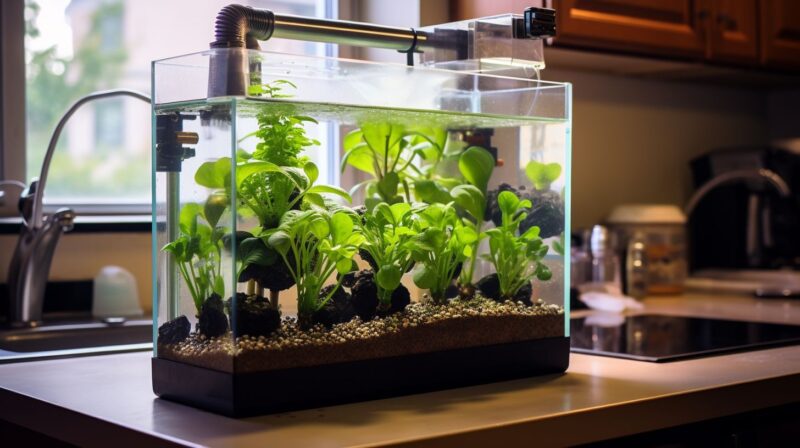
If you’re new to aquaponics, let’s start with a brief overview. Aquaponics is a system that involves the symbiotic cultivation of plants and fish. The fish provide nutrients for plants via waste, while plants purify water for fish. It’s a self-sustaining system that requires less water and fertilizer than traditional gardening methods.
When it comes to small aquaponics systems, the same principles apply, but on a smaller scale. These systems can be adapted to fit in any small space, including apartments, balconies, and even small backyard areas.
The key components of any aquaponics system are the fish tank, grow bed, and water pump. In a small aquaponics system, the size of these components will be smaller, but the principles remain the same. The fish tank provides a habitat for fish, while the grow bed cultivates plants. The water pump circulates water between the two.
The Relationship Between Fish and Plants
The relationship between fish and plants is the cornerstone of aquaponics. Fish produce waste, which contains high levels of nitrogen and other nutrients. In a traditional fish tank, this waste builds up and becomes toxic to the fish. However, in an aquaponics system, the waste is used as fertilizer for the plants.
The plants absorb the nutrients from the waste, which helps them grow faster and more robust. As the plants grow, they purify the water for the fish by removing toxins and excess nutrients.
This symbiotic relationship creates a self-sustaining system that requires very little maintenance once set up correctly. The fish provide food for you and your family, while the plants provide fresh, healthy produce.
Now that you understand aquaponics systems let’s explore how to set up a small-scale system perfect for small spaces.
Choosing the Right Setup for Small Spaces
If you’re interested in setting up an aquaponics system in a small space, several options are available. Indoor setups are popular for those who want to grow plants year-round without worrying about the weather outside. If you’re feeling handy, a DIY aquaponics system can be a cost-effective way to get started.
When choosing a setup, consider the available space you have. A small aquaponics system may be the best option if you have limited space. This could be a small fish tank or aquarium that can be set up on a countertop or table. Alternatively, you could consider using a vertical system that doesn’t take up much floor space.
A DIY aquaponics system can be fun and rewarding, but be sure to research beforehand. Ensure you have all the necessary components for your system, such as a fish tank, grow bed, and water pump. Remember that small-scale systems require less space and fewer materials, making them easier to manage.
Essential Components for Small-Scale Aquaponics
When designing an aquaponics system for a small space, it is essential to select the components that will be used carefully. The three core components of any aquaponics system are the fish tank, the grow bed, and the water pump.
Fish Tank
The fish tank is the heart of your aquaponics system, as it houses the fish that provide the nutrients for your plants. When selecting a fish tank for a small-scale system, it is vital to consider the available space and the number of fish you plan to keep. A good rule is to have one gallon of water for every inch of fish. Choose a tank appropriate for your fish and fits comfortably in your space.
Grow Bed
To put it simply, the grow bed is the place where your plants will grow and flourish. In a small aquaponics system, a single grow bed is usually sufficient. When selecting a grow bed, consider the type of plants you want to grow and the space available. A standard size for a small aquaponics system is a 2′ x 4′ grow bed.
Water Pump
The water pump circulates water between the fish tank and the grow bed. When selecting a water pump for a small aquaponics system, consider the flow rate and the head height. A 100-200 gallons flow rate per hour is usually sufficient for a small system. The head height is the vertical distance the water must travel and should be factored into your pump selection to ensure efficient water flow.
Overall, selecting the right components for your small aquaponics system is critical to its success. When setting up your aquaponics system, carefully choosing and integrating each component is crucial to ensure a healthy ecosystem for your fish and plants, resulting in optimal yield.
Maintaining Water Quality in a Small Aquaponics System
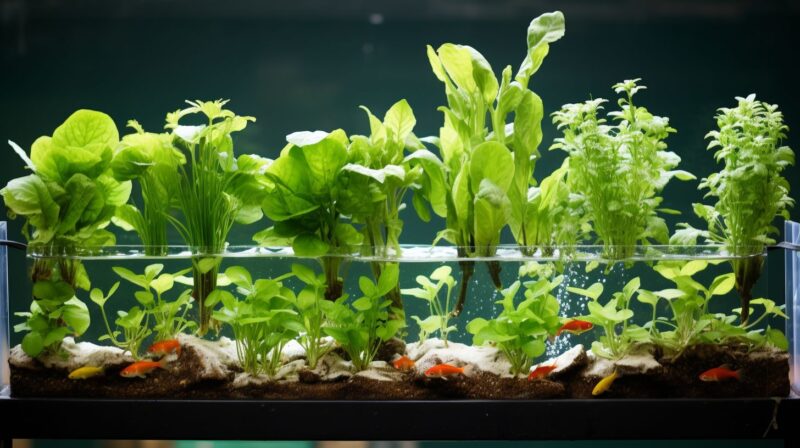
Maintaining water quality is crucial for the success of your small aquaponics system. To keep your fish and plants healthy, you must regularly monitor the water parameters and ensure that the nitrifying bacteria are thriving.
Test the Water
You should test your aquaponics system’s water weekly to ensure appropriate pH, ammonia, nitrite, and nitrate levels. Testing these parameters can be done using a test kit.
Build Nitrifying Bacteria
Nitrifying bacteria convert fish waste into plant nutrients. You can build up these bacteria by adding a small amount of ammonia to your system and allowing it to cycle for several weeks before introducing fish or plants.
Balance Fish and Plant Ratios
Overloading your system with too many fish or plants can upset your aquaponics system’s delicate balance. To keep things in check, ensure you have the appropriate number of fish for the size of your tank and grow bed, and select plants suitable for the available space.
Perform Regular Water Changes
It is essential to regularly change the water to eliminate surplus nutrients and maintain the cleanliness of the water. You should change 20-30% of the water in your system every two weeks or so.
Monitor Water Flow
Water flow is critical to ensure the nutrients are evenly distributed throughout the system. Check the flow rate of your water pump regularly and clean the filter if necessary.
You can easily maintain a healthy environment for your fish and plants and enjoy a successful small aquaponics system.
Maximizing Plant Growth in Limited Space
One advantage of aquaponics is growing plants in a small space. To make the most of your setup, consider incorporating hydroponic techniques. Hydroponics is a soil-less method of plant cultivation that utilizes water and nutrients to support growth. This method can increase growth and yield, giving plants constant access to nutrients.
When selecting plants for your aquaponics system, consider those well-suited to limited space. Lettuce, herbs, and leafy greens are suitable for small aquaponics setups.
To optimize plant growth, focus on nutrient management. Regularly test water parameters to ensure that they are suitable for supporting plant growth. Use organic fertilizers and supplements as needed to provide the necessary nutrients.
Using Clay Pebbles for Plant Growth
Clay pebbles are a popular growing medium in aquaponics systems. These small, porous balls are lightweight and provide excellent drainage and aeration for plant roots. They are handy for small spaces, as they can be used in various plant containers.
To use clay pebbles in your aquaponics system, simply fill a plant container with the pebbles and place your plant on top. Water will flow easily through the pebbles, providing the roots with nutrients and oxygen.
Consider Vertical Plant Growth
If you are truly limited in space, consider growing plants vertically. This can be achieved by placing containers on shelves or walls or using vertical growing systems designed explicitly for aquaponics. This method can increase the amount of plants you can grow in a small space.
Aquaponics is a versatile and efficient system for growing plants in small spaces. By incorporating hydroponic techniques, selecting suitable plants, and optimizing nutrient management, you can maximize plant growth and yield in your small-scale aquaponics system.
Troubleshooting Common Challenges in Small Aquaponics Systems
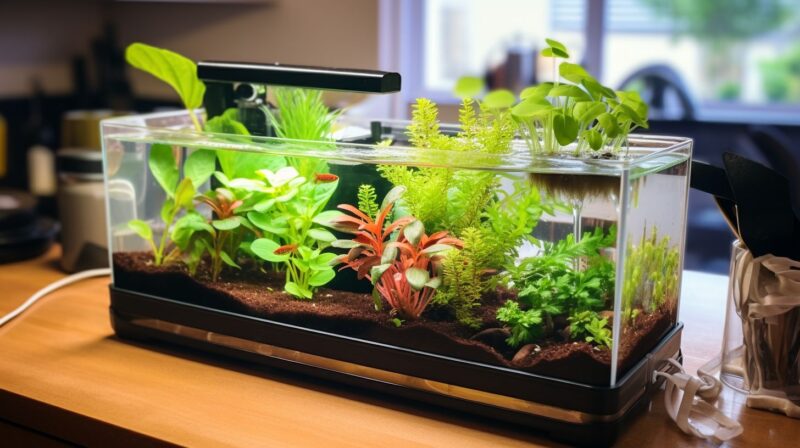
Dealing with Pests
Pests can be challenging in any aquaponics system, even in small spaces. Insects and other critters can damage plants and disrupt the system’s delicate balance. To prevent pests from becoming a problem, keep the area around your aquaponics system clean and debris-free. If you’re looking for an alternative to chemical pest control, consider using natural methods such as introducing ladybugs and praying mantises to your garden. These insects are known to effectively control pests and are a safer option for your plants and the environment.
Ensuring Proper Water Flow
Proper water flow is essential for the health of your fish and plants. If water doesn’t flow correctly, waste and harmful substances build up. To ensure proper water flow, ensure your pump works perfectly, and all hoses and connections are secure. You may also need to adjust the flow rate of the water to optimize the system for your specific setup.
Providing Suitable Fish Food
Fish food is another important factor to consider in a small aquaponics system. If your fish are not getting enough food, they may not be able to produce enough waste to fertilize the plants properly. On the other hand, if you overfeed your fish can lead to a buildup of excess debris and harmful substances in the water. To find the right balance, feed your fish small amounts of food and monitor their behavior and waste output. Adjust the amount of food as necessary to ensure your fish and plants thrive.
Conclusion: Aquaponics System for Small Spaces
In conclusion, designing an aquaponics system for small spaces offers a rewarding and sustainable way to grow plants and raise fish. Understanding the symbiotic relationship between fish and plants is essential, and careful consideration of components, water quality maintenance, maximizing plant growth, and troubleshooting common challenges will ensure success in your small-scale aquaponics endeavor. With the right setup and proper care, you can create a thriving ecosystem and enjoy fresh produce and fish from your aquaponics system in even the most limited of spaces. Happy aquaponic gardening!

